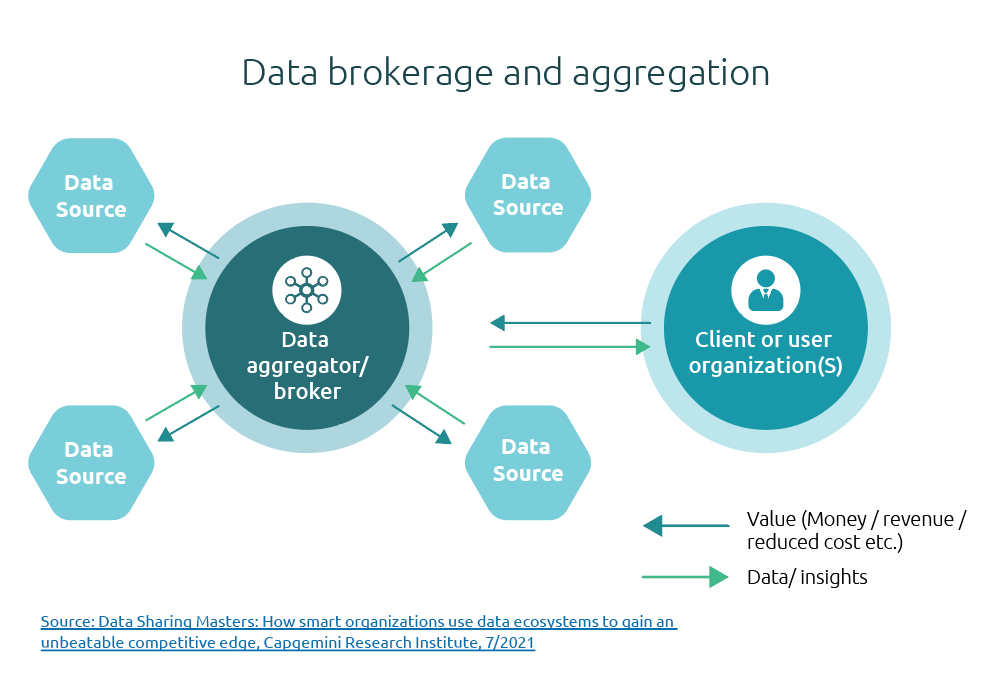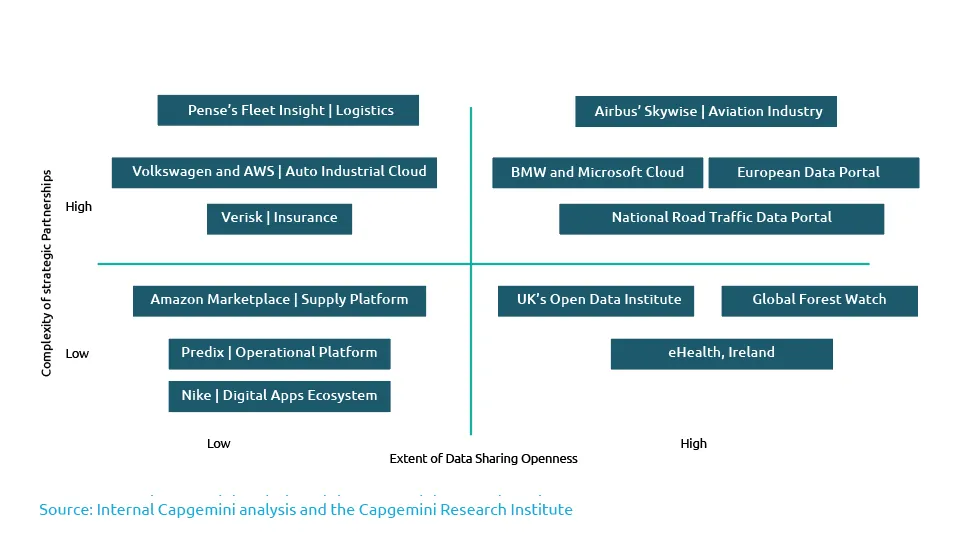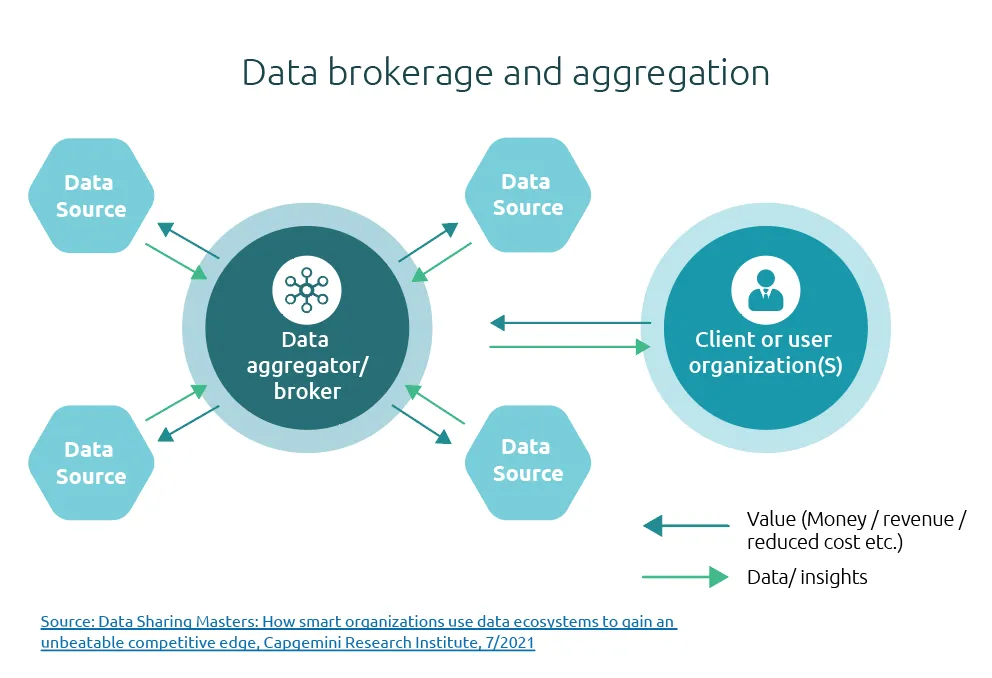Collaborative data ecosystems
Blog: Capgemini CTO Blog
Defining data ecosystems The Capgemini Research Institute (CRI) defines a data ecosystem as a partnership between multiple institutions to share and manage data to create new value that would not have been possible in the previous, siloed system.” Data sharing is based on mutual value exchange, thus making data more beneficial for all participants. Data coming from a variety of sources also enhances the diversity of information and increases inclusivity for all individuals, consumers, and citizens. This sharing happens in compliance with all local regulations and guidelines, and in an anonymous and aggregate manner (especially for personal data). In a typical data ecosystem, multiple organizations, contributors, aggregators, and user organizations come together to facilitate data sharing and provide value.
Data ecosystems are on the rise
Data ecosystems help in building economies of scale and a collaboration network. Many organizations with similar interests join ecosystems to pursue common goals. According to recent work by the Capgemini Research Institute, 77 percent of organizations globally engage in some form of the data ecosystem and two in three of these organizations (66 percent) see that there has been a renewed interest in engaging with data ecosystems in the last one to three years. Forty-eight percent of organizations plan to launch new data-ecosystem initiatives in the near future, and 25 percent of organizations will invest upwards of $50 million in data ecosystems in the next two to three years.
 Data ecosystems offer benefits across operating models for positive business impact and societal good. According to the Capgemini Research Institute study, organizations have improved customer satisfaction by 15 percent, improved productivity and efficiency by 14 percent, and reduced costs by 11 percent annually in the last two to three years by engaging in data ecosystems.
Data ecosystems offer benefits across operating models for positive business impact and societal good. According to the Capgemini Research Institute study, organizations have improved customer satisfaction by 15 percent, improved productivity and efficiency by 14 percent, and reduced costs by 11 percent annually in the last two to three years by engaging in data ecosystems.
Types of data ecosystems
In this article, we focus on two types of data ecosystems:
- Industry data ecosystems – We have seen an emergence of sector-specific data ecosystems across a range of industries, from financial services to auto to aviation.
- Open data ecosystems – Typically, these are organizations that share data in the open for societal benefits.
There are other types of data ecosystems as well. The recent study ‘Data sharing masters: How smart organizations use data ecosystems to gain an unbeatable competitive edge’ describes all of them in detail:
- Data brokerage and aggregation ecosystems
- Reciprocal data-sharing ecosystems
- Federated analytics ecosystems
- Collaborative data supply-chain ecosystems.
The matrix in the illustration maps examples of specialized industry and open data ecosystems on two key dimensions. The x-axis explores the extent of data-sharing openness. Typically, this translates to the degree to which data ecosystem participants share data openly for societal good. The y-axis explores the complexity of strategic partnerships. Typically, this translates to the number of participants involved in the data ecosystem.

Here are some examples of specialized industry data ecosystems mapped in this way:
- Airbus’ Skywise
This is a leading open data platform for the aviation industry. Its ecosystem of partners includes over 9,000 connected aircrafts from more than 100 airlines from around the world, and over 18,000 unique users. Using data and insights from the Skywise program, a US flagship carrier saved $13 million in fuel costs per year. Another airline reduced reliability reporting time from three weeks to one day. - Volkswagen and AWS for Auto Industrial Cloud
Volkswagen is working with AWS to move its 124 factory sites to a single architecture: the Volkswagen Industrial Cloud. The Industrial Cloud takes transformation beyond automation and consists of three parts: the Digital Production Platform, targeting all Group plants and built on AWS; a Volkswagen Group App Store, with use-case applications available for all partners; and the company’s machines and equipment on the shop floor. - BMW and Microsoft Cloud
Microsoft and the BMW Group launched the Open Manufacturing Platform. Companies are partners in a new initiative to drive open industrial IoT development and help grow a community to build future Industry 4.0 solutions.
And here are a few illustrative examples of open data ecosystems:
- European Data Portal
The EU Data Portal (data.europa.eu) provides access to open data made available across Europe to organizations and the general public. There are over 760,000 datasets from 35 countries, available across all major sectors and 82 catalogues (e.g. portals of open data from various EU countries, government departments, and agencies), ready for use via various open-data licenses.
- UK’s Open Data Institute (ODI)
The mission of ODI is to work with companies and governments to build an open, trustworthy data ecosystem. The ODI’s global network includes individuals, businesses, start-ups, franchises, collaborators, and governments who help to achieve the mission.
- Global Forest Watch.
GFW is anopen platform that provides data aggregated from various sources to monitor forests. The data is sourced from more than 100 organizations across the world. The platform is used by local law enforcement officers to identify threats to forest covers, analyze tree-cover change driven by external factors, and conserve wildlife.
- National Road Traffic Data Portal (NDW), Netherlands
The NDW is the national portal for traffic data in the Netherlands. NDW collects current traffic data and situation data (e.g., condition and availability of a specific road) and offers this as open data and paid services to cities and businesses in the Netherlands. One such implementation of this data set comes in collaboration with Utrecht. The city administration uses data from NDW along with other sources to provide up-to-date and accurate information to employees in traffic management.
Key challenges
Clearly, data ecosystems help to create a sustained advantage for participants. However, some key challenges need to be addressed. First, the right business model needs to be established that contains a unique value proposition and is an obvious win-win for all participants. Second, especially when data is personal or in other ways sensitive, issues around data ownership, regulatory compliance, ethics, trust, and privacy need to be addressed.
#dataecosystems #analytics #ai #ecosystems #opendata
INNOVATION TAKEAWAYS
Ecosystem
Industry data ecosystems and open data ecosystems are on the rise, as prime examples of the next generation of value-creation through collaboration on data.
Win-win
Find the right business model and define a unique value proposition that is a win-win for all data ecosystem participants.
Trust and ethics at the heart
Address issues of data ownership, regulatory compliance, ethics, trust, and privacy – as a foundational quality of any data ecosystem.
Interesting read?
Data-powered Innovation Review | Wave 2 features 21 such powerful stories from our leading technology partners and global top experts, covering fields like data for a better society, autonomous systems, data mesh architecture, creative AI, and data sharing ecosystems which will inspire you and activate your innovation muscles. Download your copy here!
Authors –

Ron Tolido, EVP, CTO, Chief Innovation Officer, Insights & Data, Capgemini
LinkedIn: https://www.linkedin.com/in/rtolido/

Monish Suri, Global Innovation Lead & Google Alliance Lead, Insights & Data, Capgemini
LinkedIn: https://www.linkedin.com/in/monishsuri/
